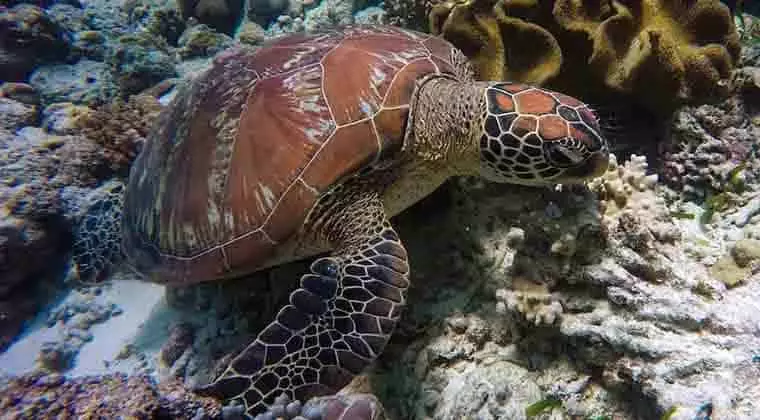Have you ever wondered how long turtles can stay underwater? These aquatic reptiles have long fascinated humans with their slow movements and unique features. One of the most intriguing aspects of turtles is their ability to hold their breath for extended periods of time.
Some turtles can stay submerged for up to five hours, while others can only hold their breath for a few minutes. The ability to stay underwater for extended periods is due to a variety of factors, including the turtle’s size, weight, and activity level.
Factors That Affect a Turtle’s Ability to Stay Underwater
Turtles are reptiles that have adapted to aquatic environments, making them highly specialized in their habitat. They have developed several features that enable them to stay underwater for extended periods. Several factors influence how long a turtle can stay underwater, and these include:
- Species: Different species of turtles have different capacities for holding their breath.
- Age: Younger turtles can hold their breath for a shorter time than adult turtles.
- Size: Smaller turtles require less oxygen and can hold their breath for longer periods than larger turtles.
- Health: Healthy turtles can hold their breath longer than those that are sick or injured.
- Activity level: Turtles that are active and moving around require more oxygen than those that are resting.
How Long Can Turtles Stay Underwater?
Turtles can stay underwater for varying amounts of time, depending on the species and their activity level. Most turtles can hold their breath for 30-60 minutes, while some sea turtles have been known to hold their breath for up to 4-7 hours during periods of rest.
The amount of time a turtle can stay underwater varies from species to species, with some being able to hold their breath for several hours. Here are some estimates of how long different species of turtles can hold their breath:
| Turtle Species | Underwater Time |
|---|---|
| Olive Ridley Turtle | Up to 50 minutes |
| Leatherback Turtle | Up to 85 minutes |
| Snapping Turtle | Up to 45 minutes |
| Loggerhead Turtle | Up to 4 hours |
| Green Sea Turtle | Up to 5 hours |
| Hawksbill Turtle | Up to 1 hour |
| Painted Turtle | Up to 30 minutes |
| Box Turtle | Up to 30 minutes |
| Red-eared Slider Turtle | Up to 45 minutes |
It’s worth noting that these figures are just estimates, and the actual duration that a turtle can hold its breath can vary widely depending on the factors we discussed earlier.
Adaptations That Allow Turtles to Stay Underwater
Turtles have evolved several adaptations that enable them to stay underwater for extended periods. One of the most important is their ability to slow down their metabolism when they are not getting enough oxygen. This adaptation helps them conserve energy and stay underwater for longer.
Additionally, turtles can store oxygen in their muscles, which allows them to use it when they are not breathing. Some species of turtles also have specialized structures in their cloacas that extract oxygen from the water, enabling them to stay underwater for extended periods.
Conclusion
The ability of turtles to stay underwater for extended periods of time is truly remarkable. While the exact duration varies depending on the species, age, and environmental factors, turtles can typically hold their breath for several minutes up to several hours.
Understanding how turtles breathe and survive underwater can help us appreciate their unique adaptations and inspire us to protect these amazing creatures and their habitats.
FAQs
How do turtles stay underwater for so long?
Turtles can hold their breath for extended periods of time because they have the ability to slow down their metabolism and reduce their heart rate. When a turtle submerges itself, it can divert blood flow away from nonessential organs and tissues, like its limbs, and use oxygen more efficiently.
What do turtles eat underwater?
Aquatic turtles eat a variety of food, including fish, insects, plants, and other animals that live in the water.
Can turtles drown?
Yes, turtles can drown if they are unable to reach the surface to breathe. This can happen if they become trapped or injured underwater.
How can we help turtles stay underwater longer?
To help turtles stay underwater longer, it is important to protect their habitats and reduce the impact of human activities, such as pollution and climate change. Additionally, reducing the use of fishing gear that can trap or entangle turtles can help ensure they have access to the surface to breathe.
How do turtles breathe underwater?
Turtles have lungs, but they can extract oxygen from water using specialized membranes in their mouths and throats. They can also store oxygen in their blood and tissues.
Are some turtles better at holding their breath than others?
Yes, some turtle species are better adapted to staying underwater than others. Sea turtles, for example, have larger lungs and can extract more oxygen from each breath than other turtle species. Some freshwater turtle species have also evolved adaptations to help them hold their breath longer, such as the ability to absorb oxygen through their skin.
